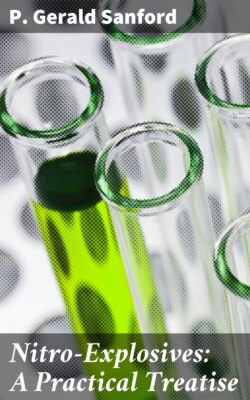Читать книгу Nitro-Explosives: A Practical Treatise - P. Gerald Sanford - Страница 25
На сайте Литреса книга снята с продажи.
MANUFACTURE OF NITRO-GLYCERINE.
ОглавлениеProperties of Nitro-Glycerine—Manufacture of Nitro-Glycerine—Nitration—
The Nathan Nitrator—Separation—Filtering and Washing—The Waste Acids—
Treatment of the Waste Acid from the Manufacture of Nitro-Glycerine and
Gun-Cotton.
~Properties of Nitro-Glycerine.~—Nitro-glycerol is a heavy oily liquid of specific gravity 1.6 at 15° C., and when quite pure is colourless. The commercial product is a pale straw yellow, but varies much according to the purity of the materials used in its manufacture. It is insoluble in water, crystallises at 10.5° C., but different commercial samples behave very differently in this respect, and minute impurities prevent or delay crystallisation. Solid nitro-glycerol[A] melts at about 12° C., but requires to be exposed to this temperature for some time before melting. The specific gravity of the solid form is 1.735 at +10° C.; it contracts one-twelfth of its volume in solidifying. Beckerheim[B] gives the specific heat as 0.4248 between the temperatures of 9.5° and 9.8° C., and L. de Bruyn gives the boiling point as above 200°.
[Footnote A: Di-nitro-mono chlorhydrin, when added to nitro-glycerine up to 20 per cent., is said to prevent its freezing.]
[Footnote B: Isb., Chem. Tech., 22, 481–487. 1876.]
Nitro-glycerine has a sweet taste, and causes great depression and vertigo. It is soluble in ether, chloroform, benzene, glacial acetic acid, and nitro-benzene, in 1.75 part of methylated spirit, very nearly insoluble in water, and practically insoluble in carbon bisulphide. Its formula is C_{3}H_{5}(NO_{3})_{3}, and molecular weight 227. When pure, it may be kept any length of time without decomposition. Berthelot kept a sample for ten years, and Mr. G. M'Roberts, of the Ardeer Factory, for nine years, without their showing signs of decomposition; but if it should contain the smallest trace of free acid, decomposition is certain to be started before long. This will generally show itself by the formation of little green spots in the gelatine compounds, or a green ring upon the surface of liquid nitro-glycerine. Sunlight will often cause it to explode; in fact, a bucket containing some water that had been used to wash nitro-glycerine, and had been left standing in the sun, has in our experience been known to explode with considerable force. Nitro-glycerine when pure is quite stable at ordinary temperatures, and samples have been kept for years without any trace of decomposition. It is very susceptible to heat, and even when quite pure will not stand a temperature of 100° C. for a longer period than a few hours, without undergoing decomposition. Up to a temperature of 45° C., however, properly made and purified nitro- glycerine will remain unchanged almost indefinitely. The percentage composition of nitroglycerine is as follows:—
Found. Theory for C_{3}H_{5}(N0_{2})_{3}.
Carbon 15.62 15.86 per cent.
Hydrogen 2.40 2.20 "
Nitrogen 17.90 18.50 "
Oxygen … 63.44 "
The above analysis is by Beckerheim. Sauer and Adou give the nitrogen as 18.35 to 10.54 per cent. by Dumas' method; but I have never found any difficulty in obtaining percentages as high as 18.46 by the use of Lunge's nitrometer. The decomposition products by explosion are shown by the following equation—
